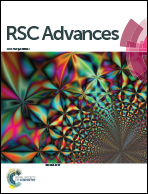Nanoflake driven Mn2O3 microcubes modified with cooked rice derived carbon for improved electrochemical behavior†
Abstract
Mn2O3 microcubes, symmetrically formed out of the systematic stacking of nanoflakes, built with nanoparticles in the 30–50 nm range have been obtained from a simple co-precipitation method. Excluding the requirement of a structure directing additive, the currently adopted synthesis protocol signifies the vital role of the rate of (NH4)HCO3 precursor addition, which has been optimized as 2 h for 300 mL to obtain uniformly stacked nanoflakes of Mn2O3 to form microcubes with desired morphological features. Cooked rice carbon (CRC), obtained from a filth-to-wealth conversion, has been used as conducting additive and an optimum concentration of 20 wt% CRC was found to be sufficient to form Mn2O3/CRC with improved lithium intercalation/de-intercalation behavior. The twin advantages, namely exploitation of a cheap and eco-benign composite additive obtained from a common domestic waste in the form of CRC and the optimized speed of addition of (NH4)HCO3 to form Mn2O3 microcubes obtained from nanoflakes offer advantages in terms of enhanced electronic conductivity and provision to buffer the volume changes of Mn2O3 anode, respectively. The optimized Mn2O3/CRC-20 composite anode exhibits an appreciable capacity of 830 mA h g−1 after formation cycle and an acceptable capacity of 490 mA h g−1 after completing 100 cycles, under the influence of 50 mA g−1 current density. Further, Mn2O3/CRC-20 anode exhibits a reasonable capacity of 450 mA h g−1 at 100 mA g−1 up to 50 cycles and qualifies itself as a potential anode material.


 Please wait while we load your content...
Please wait while we load your content...